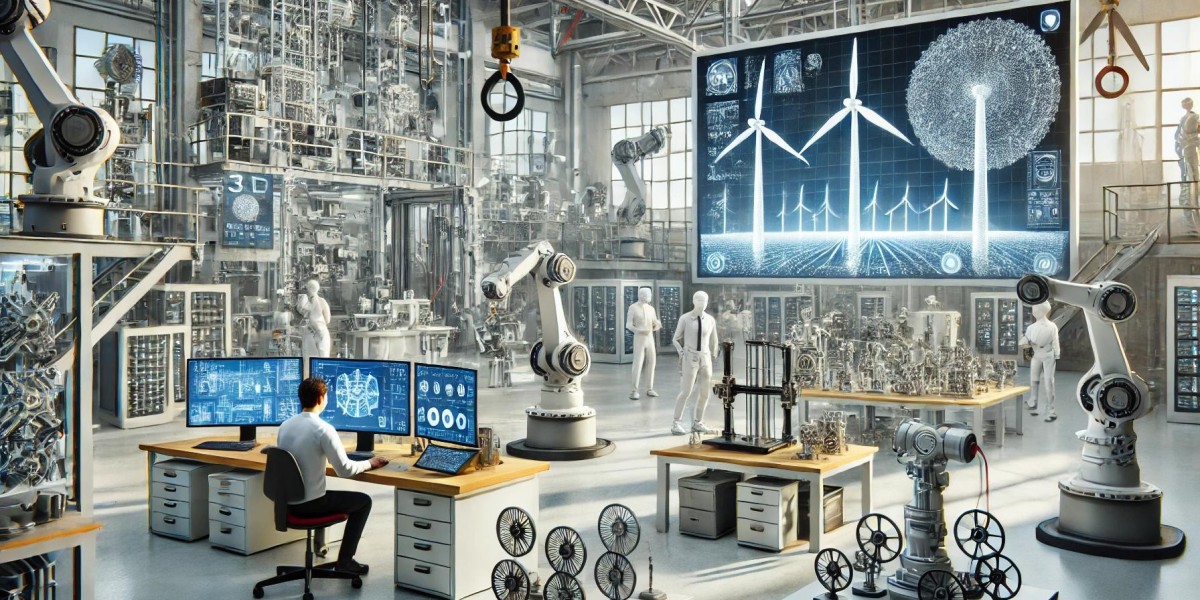Mechanical engineering has been a cornerstone of technological development for centuries. From the steam engines of the Industrial Revolution to modern-day robotics, mechanical engineers have continually pushed the boundaries of what is possible. As we look to the future, the field is poised for transformative changes, driven by technological advancements, sustainability demands, and new industry challenges. In this blog, we’ll explore some of the most exciting developments shaping the future of mechanical engineering and how they might revolutionize industries around the world. Click Here
1. Artificial Intelligence and Automation
Artificial intelligence (AI) and automation are already playing a major role in mechanical engineering, and their influence is expected to grow exponentially. AI-driven tools can now assist engineers in designing more efficient systems, optimizing performance, and predicting failures before they occur. With the use of machine learning algorithms, engineers can simulate and analyze complex systems in ways that were once impossible, reducing the time and cost of product development.
In manufacturing, automation is leading to smarter production lines where machines not only work alongside human operators but also learn and adapt to improve their efficiency. The rise of Industry 4.0, or the fourth industrial revolution, is bringing together AI, robotics, and IoT (Internet of Things) to create "smart factories" that are more efficient, flexible, and capable of producing complex products on demand.
2. 3D Printing and Additive Manufacturing
One of the most significant technological advancements in mechanical engineering is the rise of 3D printing or additive manufacturing. This technology allows engineers to create highly complex parts and prototypes layer by layer, directly from a digital model. Unlike traditional manufacturing methods, which often involve subtracting material from a solid block, 3D printing is more material-efficient and can reduce waste, making it an attractive option for sustainable production.
Additive manufacturing also enables the creation of intricate, customized designs that were previously impossible or cost-prohibitive to produce using conventional methods. In industries like aerospace, automotive, and healthcare, 3D printing is paving the way for lighter, stronger, and more efficient components, such as jet engine parts, custom prosthetics, and even entire vehicles.
3. Sustainable and Green Engineering
As the world grapples with the impacts of climate change, there is an increasing push for sustainability across all sectors. Mechanical engineers are playing a pivotal role in this transformation by developing solutions that reduce energy consumption, minimize waste, and promote the use of renewable resources.
In the energy sector, engineers are working on new ways to improve the efficiency of wind, solar, and hydropower systems. Solar panels, for instance, are becoming more efficient and less expensive due to advancements in materials science and design. Engineers are also exploring new methods of harnessing energy from waste, including the development of bioenergy systems that convert organic materials into fuel.
Moreover, engineers are looking at ways to reduce the carbon footprint of manufacturing processes. Innovations such as electric vehicles, energy-efficient appliances, and even carbon capture technologies are helping industries move toward greener, more sustainable practices.
4. Smart Materials
The development of smart materials is another exciting frontier for mechanical engineers. Smart materials are materials that can respond to external stimuli like heat, light, or electricity, adapting their properties accordingly. These materials have a wide range of potential applications, from self-healing materials that can repair damage in real time to shape-shifting materials that change shape when exposed to heat or pressure.
In the aerospace and automotive industries, smart materials are being used to create lighter, stronger, and more flexible components. In medical devices, they can be used to create implants that respond to changes in the body’s environment, improving the effectiveness of treatments. As research into smart materials continues, we are likely to see more breakthroughs in material science that will redefine what is possible in mechanical engineering.
5. Biomechanics and Healthcare Engineering
Mechanical engineers are increasingly finding applications in the healthcare sector, where their expertise in designing and analyzing mechanical systems is being used to improve medical devices and healthcare delivery. Biomechanics, the study of the mechanical properties of biological systems, is one area where mechanical engineering is making significant strides.
For example, engineers are developing more advanced prosthetics and exoskeletons that are lightweight, more functional, and customizable for individual users. In the medical field, mechanical engineers are also working on diagnostic tools, robotic surgical systems, and even tissue engineering, where mechanical systems play a crucial role in the development of artificial organs and tissues.
As the global population ages, the demand for healthcare innovations will only increase. Mechanical engineers will be at the forefront of addressing these challenges, ensuring that medical technologies are safer, more efficient, and accessible to everyone.
6. The Role of Simulation and Virtual Prototyping
The future of mechanical engineering is also being shaped by simulation and virtual prototyping technologies. These tools enable engineers to test and optimize designs before building physical prototypes, which saves time, reduces costs, and helps identify potential problems early in the design process.
In fields like automotive engineering, virtual prototyping allows for the simulation of crash tests, aerodynamics, and fuel efficiency without having to create a physical vehicle. In construction, simulation software is used to optimize the design and operation of buildings, ensuring they are structurally sound, energy-efficient, and sustainable.
Virtual prototyping and simulation are also critical in the development of robotics and automation systems. By simulating the operation of robots in a virtual environment, engineers can fine-tune their designs before deploying them in the real world, ensuring they function as intended and are safe to use.
Conclusion
Mechanical engineering is poised for significant transformation in the coming decades. The combination of AI, 3D printing, sustainable practices, smart materials, biomechanics, and simulation technologies will redefine how engineers approach design, manufacturing, and problem-solving. As industries continue to evolve and new challenges arise, mechanical engineers will remain at the forefront of innovation, shaping a future that is more efficient, sustainable, and technologically advanced. The field is only just beginning to explore its potential, and the possibilities are limitless. The future of mechanical engineering looks bright, and it’s an exciting time to be part of this ever-evolving discipline.


